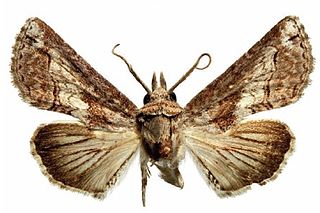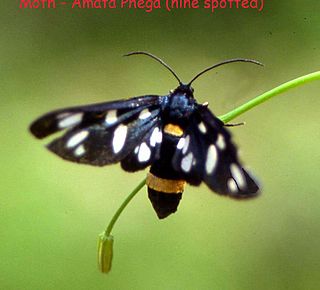
The Thyrididae comprise the family of picture-winged leaf moths. They are the only family in the superfamily Thyridoidea, which sometimes has been included in the Pyraloidea, but this isn't supported by cladistic analysis.

Eressa is a genus of moths in the family Erebidae. The genus was erected by Francis Walker in 1854.

Euteliidae is a family of moths in the superfamily Noctuoidea. The family was erected by Augustus Radcliffe Grote in 1882.
Eressa angustipenna, the black-headed wasp moth, is a moth of the family Erebidae. It was described by Thomas Pennington Lucas in 1890. It is found in Australia, as well as the Philippines.

Eressa confinis is a moth of the family Erebidae. It was described by Francis Walker in 1854. It is found in India, Bhutan, Sri Lanka, Myanmar, Taiwan and China.
Eressa furva is a moth of the family Erebidae. It was described by George Hampson in 1898. It is found in Sri Lanka and on Buru.
Eressa geographica is a moth of the family Erebidae. It was described by Edward Meyrick in 1886. It is found in Australia.
Eressa lutulenta is a moth of the family Erebidae. It was described by Snellen in 1879. It is found on Java and Sulawesi.
Eressa megalospilia is a moth of the family Erebidae. It was described by Alfred Jefferis Turner in 1922. It is found in Australia.
Eressa megatorna is a moth of the family Erebidae. It was described by George Hampson in 1898. It is found in Queensland.

Eressa pleurosticta is a moth of the family Erebidae. It was described by George Hampson in 1910. It is found in the Democratic Republic of the Congo.
Eressa multigutta is a moth of the family Erebidae. It was described by Francis Walker in 1854. It is found in Tibet, Nepal, Sikkim and Myanmar.
Eressa paurospila is a moth of the family Erebidae. It was described by Alfred Jefferis Turner in 1922. It is found in Australia.
Eressa siamica is a moth of the family Erebidae. It was described by Francis Walker in 1865. It is found in Thailand.
Eressa strepsimeris is a moth of the family Erebidae. It was described by Edward Meyrick in 1886. It is found in Australia.
Eressa subaurata is a moth of the family Erebidae. It was described by Francis Walker in 1854 and is found in Sri Lanka.
Eressa vespina is a moth of the family Erebidae. It was described by Walter Rothschild in 1912. It is found on Borneo.

The Syntomini are a tribe of moths in the family Erebidae. The tribe was erected by Gottlieb August Wilhelm Herrich-Schäffer in 1846.
Thosea aperiens, the stinging caterpillar, is a moth of the family Limacodidae. The species was first described by Francis Walker in 1865. It is found in Sri Lanka and India.



